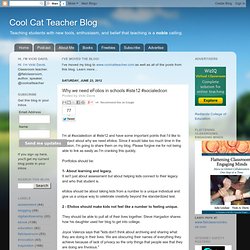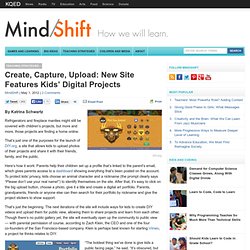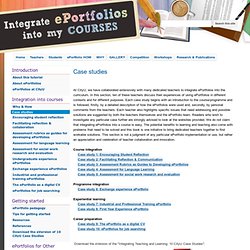

How Not to Do Portfolios. I haven’t successfully implemented portfolios in my own classroom yet, but after attending a SocialEdCon discussion about e-portfolios here at ISTE, I started thinking about the e-portfolio I created as a final graduation requirement for grad school.

It was all wrong, and that’s why I feel no sense of pride or ownership over it. Our college technology programs should be leading the way in creating e-portfolios as they send instructional technologists out into education. Teachers are like everyone else. They need models of good practices in their own education so they can implement those practices in their classrooms. Why we need eFolios in schools #iste12 #socialedcon. I'm at #socialedcon at #iste12 and have some important points that I'd like to interject about why we need efolios.

Since it would take too much time in the session, I'm going to share them on my blog. Please forgive me for not being able to link as easily as I'm cranking this quickly. Portfolios should be: 1- About learning and legacy.It isn't just about assessment but about helping kids connect to their legacy and who that student is. efolios should be about taking kids from a number to a unique individual and give us a unique way to celebrate creativity beyond the standardized test. Psdblogs.wikispaces. Psdblogs.wikispaces. 3 Keys for a Successful E-Portfolio Implementation.
Assessment | News 3 Keys for a Successful E-Portfolio Implementation Can educators help students meet standards without falling back on the low-bar, one-size-fits-all mechanism of standardized assessments?

By Sharleen Nelson06/29/11 E-portfolios can be used to do more than just demonstrate student progress toward standards. They can also allow students to show who they are as individuals, while also providing a means for tracking a student's growth from kindergarten all the way through high school and beyond. But according to David Niguidula, author and founder of Ideas Consulting, the success of an e-portfolio initiative depends to some degree on the approach schools take to the implementation. For schools looking to implement digital portfolios into the classroom, Niguidula, who presented a session on e-portfolios at this year's ISTE conference in Philadelphia, highlighted three critical elements. E-Portfolios using Web 2.0 Tools. Your Challenge The challenge for teachers is to create an ePortfolio that represents them and stands out among the thousands of teachers who are competing for the same jobs.

Participants will use Wikispaces, Google Sites, or a template to create the ePortfolio. You will be exposed to multiple Web 2.0 tools i.e. Glogster, VoiceThread, Wordle, Prezi, Voki, BlogTalkRadio, Vimeo, Picasa or Flickr, and a timeline program. We may bring in other tools or invite you to share some Web 2.0 tools. Participants will bring their own digital assets on their laptops and follow along with the presenters. Create, Capture, Upload: New Site Keeps Kids’ Digital Projects. Teaching Strategies DIY.org By Katrina Schwartz Refrigerators and fireplace mantles might still be covered with children’s projects, but more and more, those projects are finding a home online.

That’s just one of the purposes for the launch of DIY.org, a site that allows kids to upload photos of their projects and share it with their friends, family, and the public. Here’s how it work: Parents help their children set up a profile that’s linked to the parent’s email, which gives parents access to a dashboard showing everything that’s been posted on the account. Introduction to K-12 ePortfolios. Dr. Helen Barrett's Electronic Portfolios. Can Six Year Olds Really Demonstrate Their Learning? By Kathy Cassidy This week we finished up another one of our project based learning (PBL) or inquiry-based units in my first grade classroom.

It had the grand title of rules, relationships and responsibilities. Why I Let Students Take the Lead in Learning Demonstration At the end of each of our units, I have the students create an artifact that can be posted on their blog to show what each of them has learned about our topic of study. I have never been a big supporter of “tests”, especially in first grade, where the students are usually much more comfortable showing learning in a verbal way rather than a written one. Even as young as six years old, students begin to realize that they are stronger in some areas than others.
ePortfolios with GoogleApps. Case studies - TDG eP: Teachers. At CityU, we have collaborated extensively with many dedicated teachers to integrate ePortfolios into the curriculum.

In this section, ten of these teachers discuss their experiences of using ePortfolios in different contexts and for different purposes. Each case study begins with an introduction to the course/programme and is followed, firstly, by a detailed description of how the ePortfolios were used and, secondly, by personal comments from the teachers. Each teacher also highlights specific issues that need addressing and possible solutions are suggested by both the teachers themselves and the ePortfolio team. Readers who wish to investigate any particular case further are strongly advised to look at the websites provided. ePortfolio: Showcasing Generation NOW! ePortfolios For All: A Roadmap For Success. Templates for Student Projects - uTeach With Technology. The Vision (Our Eportfolio Project) Cc licensed flickr photo shared by U-g-g-B-o-y-(-Photograph-World-Sense-) I have recently drafted a “vision” of our school project.

I would love any feedback, thoughts, or questions on the process. Forest Green School is located in Stony Plain, Albert and is a K-6 school with Parkland School Division. We have three school sites, including Forest Green School, Connections for Learning (K-12), and Brightbank (K-6). Each site is separated in distance and serves a wide range of families and needs, but we are connected through our staff and online practices between our students. We have developed an Eportfolio project that is focused on deep, critical thinking activities with the infusion of technology. At Forest Green School, we want our students to be innovators, thinkers, collaborators, and strong citizens who lead and serve.